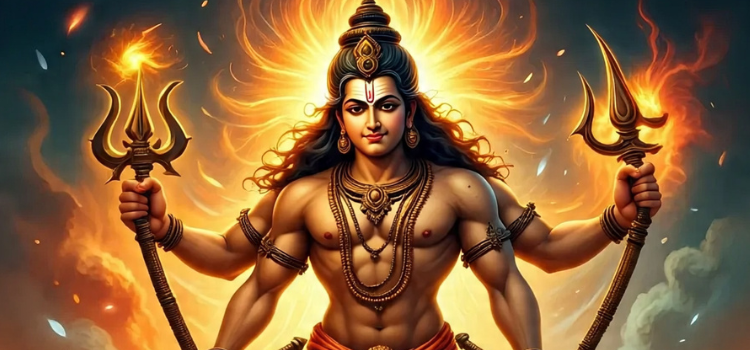Rudrashtakam is a well-known hymn dedicated to Lord Rudra, a fierce aspect of Lord Shiva. He is a powerful deity, but one whose real nature is shrouded in mystery. Devotees often invoke Rudra for protection. He represents transformative power, and is associated with storms, destruction, and spiritual liberation.
As a terrifying aspect of Shiva, Rudra signifies destruction, protection, and transformation. This deity first appeared in the Rig Veda, written in 1500 BCE; it is the earliest of the 4 Vedas.
In the ancient Hindu texts, Rudra is a storm god embodying chaos, raw energy, and destruction. Later, Rudra took on some of Shiva’s more benevolent aspects, like healing and compassion.
Rudra is wild and unpredictable, like the storms and gusty winds he controls. Thus, he acquired a dual nature where his destructive energy is balanced by his healing powers.
His wrath can destroy entire worlds, but his compassion protects and heals. He personifies all natural forces and is indispensable to the cosmic order.
He can eliminate obstacles in our lives and bestow prosperity and well-being. He ensures harmony and balance in the universe.
The Origin Story of Rudra
One story says that Rudra was born of Lord Brahma’s wrath. Brahma is the Creator Archetype in the Hindu religion. When Brahma began to create, he felt something was missing – a powerful being who could restore balance when good and evil forces were in conflict. Brahma opened his third eye in a moment filled with intensity and deep energy, and Rudra was born.
From Brahma’s eye emerged a ferocious form with a thousand eyes and a dark mien. Brahma was both alarmed and amazed by what he had created. His roar was so loud that it penetrated the entire universe. Every being was overcome by terror and awe on seeing him. Brahma gave him many names and forms representing his many qualities.
These forms later came to be called the 11 Rudras, each embodying a different aspect of Rudra’s divine power.
What Does ‘Rudra’ Mean?
“Rudra” is a Sanskrit word that comes from the root ‘Rud,’ which means “to cry, to howl,” or “to be fierce”. This evokes Rudra’s nature, for he is a storm god who induces fear but brings renewal. Fierceness is integral to Rudra’s identity, for it gives him his uncontrollable temperament and the role of cosmic destroyer.
Shiva’s Rudra avatar, however, represents a different aspect. Shiva embodies calmness and tranquillity that liberate one’s soul. He is full of benevolence and compassion. Rudra stands for chaos and destruction, while Shiva represents grace and serenity. These two forms highlight the stark contrast between creation and destruction, chaos and order, anger and compassion.
Lord Shiva as Rudra
Rudra’s storm-like energy is apparent in his many manifestations. Each Rudra signifies a specific aspect of Shiva’s wrath and cosmic purposes. While some Rudras are related to fires and storms, others are associated with protection and recuperation. The eleven Rudras help maintain the balance between creation, preservation, and destruction in the cosmos.
Each Rudra represents some traits of Shiva, like wisdom, ferocity, and compassion. Some Rudras destroy evil so that others can be reborn or healed. Thus, they manage to preserve the balance in the cosmos.
Rudrashtakam Stotram
Rudrashtakam was composed by Tulsidas, a Bhakti saint. It is a devotional hymn in Sanskrit on Lord Shiva or Rudra. It is found in the Uttara Kanda of the Ram Charit Manas.
Rudrashtakam comprises eight stanzas. These sing the praises of Shiva and describe the deity’s qualities and exploits, including the destruction of Tripura, the burning of Kamadeva, etc.
According to mythology, the demon king of Lanka, Ravana, who was a great devotee of Shiva, used this hymn to pacify Shiva and seek his forgiveness. When Ravana visited Mt. Kailas, the abode of Shiva, Goddess Parvati, the consort of Shiva, tried to awaken him. But he was very engrossed in listening to some music and pushed Ravana down the mountain as he did not want to be disturbed. He was about to punish Ravana by sending him to Paatal lok when Ravana chanted this Stotram during Pradosham time to calm him down. A pleased Shiva is said to have forgiven him.
Another story says that Rama sang the Rudrashtakam before going to battle against Ravana to get Shiva’s blessings for victory in the war.
As per the scriptures, reciting the Rudrashtakam can get rid of all problems, diseases, and enemies. It can give you the power and energy to achieve success in all endeavors. It is the best way to praise and please Shiva.
Rudrashtakam Lyrics
Namami Shamishan Nirvan Roopam
Vibhum Vyapakam Brahma Veda Swaroopam |
Nijam Nirgunam Nirvikalpam Nireeham
Chidakaash Maakash Vaasam Bhajeham || 1 ||
Nirakaar Omkar Moolam Turiyam
Giragyaan Goteet Meesham Girisham |
Karaalam Mahakaal Kaalam Kripalam
Gunagaar Sansaar Paaram Naatoham|| 2 ||
Tusharaadri Sankaash Gauram Gabheeram
Manobhoot Koti Prabha Shi Shareeram |
Sfooranmauli Kallolini Charu Ganga
Lasadbhaal Baalendu Kanthe Bhujanga|| 3 ||
Chalatkundalam Bhru Sunethram Vishaalam
Prasannananam Neelkantham Dayalam |
Mrigadheesh Charmaambaram Mundamaalam
Priyam Shankaram Sarvanaatham Bhajaami || 4 ||
Prachandam Prakrishtam Pragalbham Paresham
Akhandam Ajambhaanukoti Prakaasham |
Trayahshool Nirmoolanam Shoolpaanim
Bhajeham Bhawani Patim Bhaav Gamyam || 5 ||
Kalateet Kalyaan Kalpantkaari
Sada Sajjanaanand Daata Purari |
Chidaanand Sandoh Mohapahari
Praseed Praseed Prabho Manmathari || 6 ||
Nayaavad Umanath Paadaravindam
Bhajanteeha Lokey Parewa Naraanaam |
Na Tawatsukham Shaantisantapnaasham
Praseed Prabho Sarvabhootadhivaasam || 7 ||
Na Jaanaami Yogam Japam Naiva Poojaam
Na Toham Sada Sarvada Shambhu Tubhhyam |
Jarajanm Dukhhaudya Taapatyamaanam
Prabho Paahi Aapan Namaami Shri Shambho || 8 ||
Rudrashtakamidam Proktam Vipren Hartoshaye |
Ye Pathanti Naraa Bhaktaya Teyshaam Shambhu Praseedati ||
